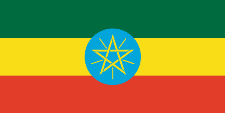Categories and Subject Descriptors
J.1 [Computer Applications]: Administrative Data Processing – Education. K.3.1 [Computers and Education]: Computer Uses in Education
Optimism for the Impoverished:
How Computers in Every Classroom Would Help Ethiopia Meet Millennium Development Goal Two
 Ethiopia is a country perennially on the bottom of the list when it comes to information and communication technology (ICT), according to the U.N.’s Global Information Technology Readiness Reports (GITR). Ethiopia is at the top of the list when it comes to need. One of the oldest civilizations, Ethiopia has had a tumultuous history which is one reason for the challenges it faces today. The topology of Ethiopia, largely a high arable plateau, makes it ripe for agricultural development. Irrigation is problematic because most of its lakes and rivers lie at much lower elevations. Ethiopia’s educational system is one of the worst in the world having the second highest illiteracy rate in sub-Saharan Africa. Weak laws, a judicial system that can be politically swayed and the lack of an international bank presence create a negative economic climate not suitable for foreign direct investment. Ethiopia’s telecommunication system needs to be completely overhauled and are not conducive to even a 33 kbps modem signal. All of the factors just mentioned are some of the reasons Ethiopia is at the bottom of the Network Readiness Index (NRI) of the GITR report
Ethiopia is a country perennially on the bottom of the list when it comes to information and communication technology (ICT), according to the U.N.’s Global Information Technology Readiness Reports (GITR). Ethiopia is at the top of the list when it comes to need. One of the oldest civilizations, Ethiopia has had a tumultuous history which is one reason for the challenges it faces today. The topology of Ethiopia, largely a high arable plateau, makes it ripe for agricultural development. Irrigation is problematic because most of its lakes and rivers lie at much lower elevations. Ethiopia’s educational system is one of the worst in the world having the second highest illiteracy rate in sub-Saharan Africa. Weak laws, a judicial system that can be politically swayed and the lack of an international bank presence create a negative economic climate not suitable for foreign direct investment. Ethiopia’s telecommunication system needs to be completely overhauled and are not conducive to even a 33 kbps modem signal. All of the factors just mentioned are some of the reasons Ethiopia is at the bottom of the Network Readiness Index (NRI) of the GITR report
To meet its Millennium Development Goal number two, giving all school aged children at least a primary school education, Ethiopia must leverage ICT to help it leapfrog over the learning gaps. Not only are more computers needed in classrooms throughout the country, but infrastructure and societal reforms must be put in place to complement the transition. Rural schools don’t have access to reliable electricity, if at all. Most of the population lives on less than $2 U.S. a day and child labor is common. Some families cannot survive without their children working. Internet connectivity is spotty and extremely expensive, even by U.S. standards. There is a patriarchal belief that resonates in Ethiopian society that girls are of less value than boys. All of these problems have tough solutions, but they are not impossible.
Ethiopia has the opportunity to benefit from technological innovation without the growing pains suffered by others. Wind farms can be installed to bring renewable reliable energy to cities, towns and villages. High speed fiber-optic Internet access can be installed in schools to educate the young during the day and adults at night. Solar power water pumps can be used to help irrigate farmer’s fields making them more efficient and productive. Donations of time, money, computers and labor are paramount to affect a change and help Ethiopia meet its Millennium Development Goals by 2015.